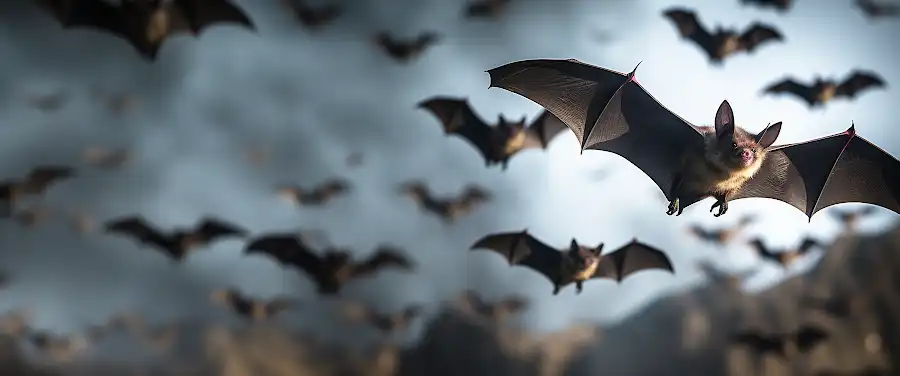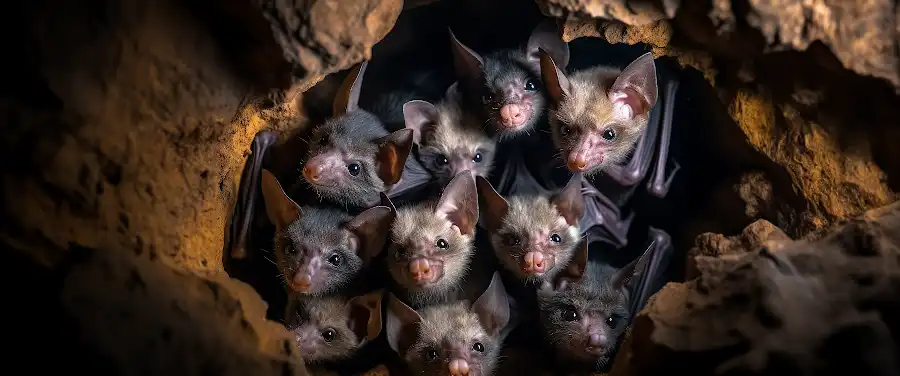
Bats: creatures of the night, shrouded in darkness and mystery. They flutter through the gloaming, silent and unseen, sparking both fascination and fear in equal measure. In our imagination, they are harbingers of doom or symbols of the supernatural, but really, they are neither. Beneath their beady eyes and the cloak of night, bats are nothing more than fellow inhabitants of our shared planet. Yet, while many of us appreciate their role in pest control and pollination, few of us are aware of the health risks that they can pose to us humans.
Our lack of understanding about bats isn’t surprising. Their nocturnal lives make them relatively obscure figures in our daily lives. But familiarity with bats becomes crucial when it comes to public health because bats are, in fact, carriers of some zoonotic diseases – illnesses that can jump the species barrier from animals to humans. From Rabies to Ebola, these winged mammals have been linked to a multitude of conditions that can spell grave consequences for human health. That’s why it’s so important to understand and respect the unknown aspects of these creatures, even as we admire their undeniable fascination.
While bats are not villainous creatures meant to bring harm, we must balance our appreciation for these winged wonders with proper precaution and awareness to prevent possible health hazards. After all, ignorance is not bliss when it comes to public health. Understanding the potential perils bats pose doesn’t make them monsters; it makes us more informed and better equipped to share the earth with all its extraordinary inhabitants.
Smoothly transitioning into our next section, we will be probing deeper into why bats are considered dangerous to human health. It’s not about painting a sinister picture of bats, but about spreading awareness, so we can coexist more safely with our nocturnal neighbors.
What are the Most Common Diseases Associated with Bats?

Bats, those charming creatures of the night, often grace the dusk with their silhouettes. Yet, contrary to their benign appearances, these mammals might carry diseases that pose significant health risks to humans. Among the most common diseases associated with bats are Rabies, Histoplasmosis, Ebola, and other viral ailments.
Rabies: A Potentially Lethal Virus
Understanding rabies and how bats may transmit it begins with recognizing the nature of this dangerous disease. Rabies is a viral disease affecting the central nervous system and can be fatal if not treated promptly. Infected bats can transmit rabies to humans through a bite or scratch, or if their saliva comes into contact with a human’s eyes, nose, mouth, or an open wound.
The Centers for Disease Control (CDC) provides an alarming statistic – roughly 70% of the reported cases of rabies in the U.S are due to bats. This disease might progress silently, showing no apparent signs until it’s too late, which heightens the health risk associated with bats.
Histoplasmosis: A Disease Linked to Bat Guano
Moving forward, Histoplasmosis is another disease directly associated with bats. It is an infection caused by breathing in the spores of a fungus often found in bird and bat droppings, particularly bat guano. This disease may exhibit flu-like symptoms, such as fever, cough, and fatigue, which could escalate to severe respiratory distress if not treated properly.
Ebola and other Viral Diseases
Moreover, bats have been implicated in the outbreak of Ebola, a devastating disease causing severe fever and, frequently, internal bleeding. Scientists have identified fruit bats as potential ‘natural hosts’ of the Ebola Virus, contributing to its spread to humans.
Bats, being highly mobile and numerous, also carry other viruses, such as Coronaviruses, Marburg Virus, and Nipah and Hendra Viruses, which can jump species to infect humans. The health risks associated with bats do not simply reside in the bats themselves but also in their potential to act as carriers for a variety of harmful pathogens.
Bats indisputably play crucial roles in our ecosystem, primarily as pollinators and pest controllers. However, understanding the potential health threats they carry is undeniable. As the old proverb “forewarned is forearmed” goes, we must educate ourselves about these issues to protect our health while respecting nature’s balance.
As we delve deeper into the world of bats, one might wonder, ” Are all Bats Dangerous to Humans?”. The answer isn’t as simple as it may seem. So stay tuned as we shed light on this intriguing question in our subsequent discussion.
Are All Bats Dangerous to Humans?

Not all bats are dangerous to humans. In fact, the majority of bat species are harmless. These nocturnal creatures play a vital role in maintaining the ecological balance, including insect control and pollination. Despite their vital ecological roles, some specific bat species are known to carry diseases that can pose a significant health risk to humans and other animals.
The geographical distribution of disease-carrying bats varies widely. According to the Centers for Disease Control and Prevention, certain bat species in North and South America, such as the common vampire bat, are known to carry rabies, a deadly virus that can be transmitted to humans and other animals. In Africa, Asia, and Europe, fruit bats are known carriers of Ebola and other dangerous viruses.
That said, encounters with disease-carrying bats can turn sour if caution is not exercised. According to the World Health Organization, approximately 55,000 people die from rabies globally every year- 99% of these cases are transmitted by domestic dogs, not bats. Nonetheless, bats account for most of the remaining cases. Here is a contextually relevant list of some of the most common diseases associated with bats:
- Rabies
- Ebola
- Marburg virus
- Histoplasmosis
- Nipah and Hendra viruses
- Coronavirus (including the strain that causes COVID-19)
While the above diseases can be fatal, it’s essential to emphasize that human contraction is extremely rare. In fact, most bat-related diseases can only be transmitted to humans if they come into direct contact with bats, particularly through bat bites, scratches, or exposure to bat feces. Remember, not all bats are disease carriers, but it’s always better to err on the side of caution when in close contact.
From an ecological standpoint, the benefits of bats to the ecosystem far outweigh the risks. The key is to respect these creatures and their habitats while maintaining a safe distance.
The bat-human interaction doesn’t necessarily have to result in disease transmission. By creating awareness about the potential health risks associated with certain bat species and promoting safe practices, we can peacefully coexist with these vital members of our global ecosystem.
Conclusion
As we conclude this enlightening journey into the health risks associated with bats, it’s vital to capture the central points we’ve discussed. In simple terms, bats, while playing an essential role in our ecosystem, do carry with them certain health risks. Understanding these dangers is crucial, not only for our well-being but for the preservation of these fascinating creatures as well.
Recapping our main highlights, bats can potentially spread diseases to humans, either directly through bites or scratches, or indirectly via other animals that they’ve infected. We’ve learned about diseases like Rabies and Nipah virus, among others, which underline the health risk associated with bats.
Despite these risks, it’s important we underscore the need for coexistence. This might sound a little scary, but remember – your chances of contracting a disease from bats are minimal provided you take certain precautions. Health safety measures, such as avoiding close contact with bats and their droppings, and vaccinating pets, can drastically reduce these risks.
Now, let’s consider the macro-context for a moment. Our interactions with bats and the potential health dangers tied to it are not just individual concerns. They’re also part of a broader narrative about human-wildlife interactions and the need for balanced ecosystem management.
The key takeaway here is, while bats do present certain health risks, understanding these risks and employing safety measures enables us to not just coexist, but indeed thrive alongside these creatures. Think of it this way: Knowledge is our greatest tool. Armed with this knowledge, we’re better prepared to negotiate our relationship with bats responsibly.
In conclusion, understanding the health risk associated with bats and taking necessary precautions empowers us to safely coexist, protecting us and the biodiversity that bats represent. Remember – a safer world doesn’t mean a world without bats, but a world where we respect boundaries and make informed, responsible decisions.




